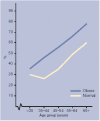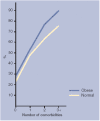The impact of obesity on drug prescribing in primary care
- PMID: 16212848
- PMCID: PMC1562331
The impact of obesity on drug prescribing in primary care
Abstract
Background: Healthcare costs attributable to obesity have previously involved estimations based on costs of diseases commonly considered as having obesity as an underlying factor.
Aim: To quantify the impact of obesity on total primary care drug prescribing.
Design of study: Review of computer generated and handwritten prescriptions to determine total prescribing volume for all drug classes.
Setting: Twenty-three general practice surgeries in the UK.
Method: Stratified random selection of 1150 patients who were obese (body mass index [BMI]>30 kg/m(2)) and 1150 age and sex-matched controls of normal weight (BMI 18.5-<25 kg/m(2)). Retrospective review of medical records over an 18-month period.
Results: A higher percentage of patients who were obese, compared with those of normal weight, were prescribed at least one drug in the following disease categories: cardiovascular (36% versus 20%), central nervous system (46% versus 35%), endocrine (26% versus 18%), and musculoskeletal and joint disease (30% versus 22%). All of these categories had a P-value of <0.001. Other categories, such as gastrointestinal (24% versus 18%), infections (42% versus 35%), skin (24% versus 19%) had a P-value of <0.01, while respiratory diseases (18% versus 21%) had a P-value of <0.05. Total prescribing volume was significantly higher for the group with obesity and was increased in the region of two- to fourfold in a wide range of prescribing categories: ulcer healing drugs, lipid regulators, beta-adrenoreceptor drugs, drugs affecting the rennin angiotensin system, calcium channel blockers, antibacterial drugs, sulphonylureas, biguanides, non-steroidal anti-inflammatories (NSAIDs) (P<0.001) and fibrates, angiotensin II antagonists, and thyroid drugs (P<0.05). The main impact on prescribing volumes is from numbers of patients treated, although in some areas there is an effect from greater dosage or longer treatment in those who are obese including calcium channel blockers, antihistamines, hypnotics, drugs used in the treatment of nausea and vertigo, biguanides, and NSAIDs (P<0.05) reflected in significantly increased defined daily dose prescribing.
Conclusions: This large study of contemporary practice indicates that obesity more than doubled prescribing in most drug categories.
Figures
Comment in
-
Impact of obesity.Br J Gen Pract. 2005 Dec;55(521):967-8. Br J Gen Pract. 2005. PMID: 16378572 Free PMC article. No abstract available.
References
-
- Bajekal M, Primatesta P, Prior G, editors. Health Survey for England 2001. London: The Stationery Office; 2003.
-
- Wing RR, Hill JO. Successful weight loss maintenance. Ann Rev Nutr. 2001;21:323–341. - PubMed
-
- Tuomilehto J, Lindstrom J, Eriksson JG, et al. Prevention of type 2 diabetes mellitus by changes in lifestyle among subjects with impaired glucose tolerance. N Engl J Med. 2001;344(18):1343–1350. - PubMed
-
- Torgerson JS, Boldrin MN, Hauptman J, Sjorstrom L. XENical in the prevention of diabetes in obese subjects (XENDOS) study: a randomized study of orlistat as an adjunct to lifestyle changes for the prevention of type 2 diabetes in obese patients. Diabetes Care. 2004;27(1):155–161. - PubMed
Publication types
MeSH terms
LinkOut - more resources
Full Text Sources
Other Literature Sources
Medical
Research Materials


